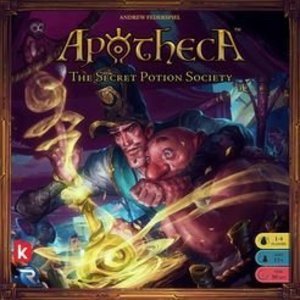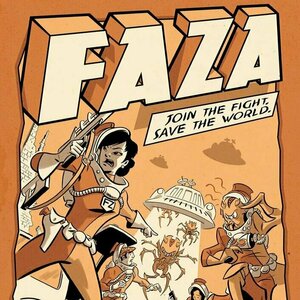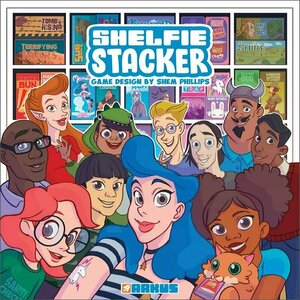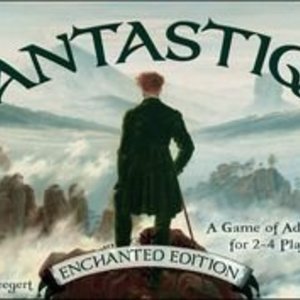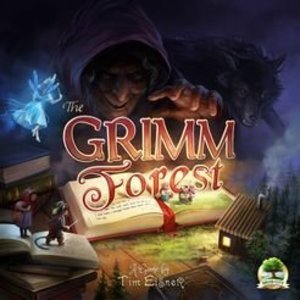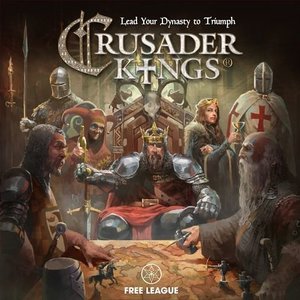
Crusader Kings
Tabletop Game
You are a Crusader King, striving for wealth, political power, religious influence, and military...
BoardGames 2018Games
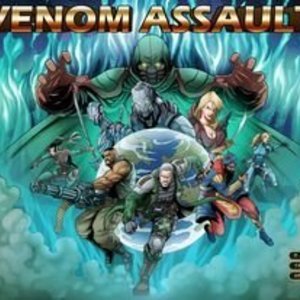
VENOM Assault
Tabletop Game
In the year 2050 the United Nations made a startling discovery that changed the course of the...
Purple Phoenix Games (2266 KP) rated Faza in Tabletop Games
Oct 28, 2020
Faza is a sci-fi, grid movement, modular board, purely cooperative board game for one to four players. In this review I will be addressing it from a solo player’s viewpoint. In my plays I have used the full complement of four characters and controlled them all simultaneously.
In Faza, players take on the roles of four Faction Zeta members tasked with saving Earth from the Faza alien race. They will accomplish this by using each character’s skills effectively and efficiently, killing alien drones invading the town tiles, and attacking motherships using the help of turncoat rebel Faza. Only one path to victory lies ahead with several ways to lose. Do you got the GUTS? DO YA??
DISCLAIMER: We were provided a copy of this game for the purposes of this review. This is a retail copy of the game, so what you see in these photos is exactly what would be received in your box. I do not intend to cover every single rule included in the rulebook, but will describe the overall game flow and major rule set so that our readers may get a sense of how the game plays. For more in depth rules, you may purchase a copy online or from your FLGS. -T
To setup a game of Faza, each player will choose a character to control throughout the game. These characters are medical, political, tactical, or technological in nature, and there are two of each from which players may choose. The map of the town is comprised of 16 tiles, and once randomly setup in a 4×4 grid players will place their color-matched meeples on the appropriate Outpost tiles along with two rebels (purple fazeeples). Each of the three mothership standees will be placed on tiles corresponding to rulebook placement along with three drones and two drones per orthogonally adjacent tiles. The Faza deck is to be shuffled and placed aside, along with the remaining drones and rebels. Each player places out their character action cards in numerical order and the game may now begin in earnest!
On a player’s turn… well, there aren’t any turns in this game. In fact, the game is played over several phases: the Team Phase and the Faza Phase. During the Team Phase players may use several free actions and one action pertaining to each of their four player action cards. Each of these cards offer the player a choice of two actions. Perhaps one side is movement and the other a bazooka. Or one is an airplane while the other is a raygun, for example. As actions are spent cards are twisted 90 degrees to keep track.
During the Team Phase players may play their actions in any order that would benefit the team best. This also includes fighting drones and sending rebels to damage the motherships. However, with every damage to the mothership taken a Faza card is drawn and put into play. These could be real bad news for the heroes, or even reward cards. They can be devastating or not so bad at all. Once players have finished the Team Phase, the action now turns to the Faza.
During the Faza Phase the Mothership Activation Tracker will move to the next mothership in sequence and activate their abilities. The motherships will typically move, do something bad to the terrain or drop more drones or destroy something, and then pass play onto the players again.
Each mothership starts the game with 4 HP and once players send enough rebels and encounter the same number of Faza cards the mothership is downed and less powerful when their ability card is activated. However, players will win once all three motherships have been defeated! On the other hand, players will lose when any one player dies of injuries from unsuccessful battles, the players run out of drones to be placed on the board when needed, all of the Outpost tiles have been terraformed by the Faza motherships, or all rebels have been removed from the board in Hard Mode.
Components. When contacted about reviewing the game I first turned to the website and watched a how to play video by Jon Gets Games. He did a great job explaining the rules clearly and succinctly. Then I happened to get a notification on BGG that Marco Arnaudo posted a video on Faza, so I watched it as well. In his video he complains that though the components are all very nice (which they are for sure) the color palette is not great. I can certainly see why he would say such a thing, but orange is my favorite color, so to see so much of it on a game is a big plus for me. Yes, having the orange drones sitting atop an orange town tile can maybe make for unpleasant color contrast, I happen to find it tolerable and enjoyable. The quality of the components is wonderful and the box has a nice heft to it. No complaints from ME about the components. Did I mention the rebels are an amazing purple color as well? No secret here that we love the color purple! Maybe even more than Oprah!
The gameplay is where it’s at for me. Marco too. We both love this little gem! The ability to sandbox your entire turn and just have one character do one action, then switch over to another character to do one or more actions, then back to the original is just so much fun. Each character has a special ability and four action cards. Even when an injury must be sustained, actions are still available, but at a much lesser potency. That’s a great way to negatively affect the players without having to completely debilitate them. To sustain an injury the player will flip their lowest-numbered action card to the back side, and once all four of their action cards are injured they are dead. D-E-D dead.
As a solo game Faza really delivers the goods. Being able to control two to four characters by oneself and determine the best order to activate abilities and move meeples around is delicious. Having certain tiles offer combat bonuses to matching characters is excellent and a great way to thin the herd of pesky drones. I really cannot say enough great things about the game. If you have never heard of this one, please don’t worry. I really hadn’t either until the designer contacted me about reviewing it. And I am certainly glad he did because this is a marvel of a game. I am looking forward to my next play against the Faza and increasing the difficulty to really bash my confidence on this one.
If you are looking for a game that is relatively quick to play and offers so many great choices, while using a wonderful art style and color palette, I urge you to check out Faza by visiting the website and ordering your copy right away. The Earth needs you to ward off the invaders and you need to play this game of mostly orange with a dash of purple.
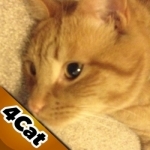
Game4Cats a Bird Hunting Game for Cats
Games and Entertainment
App
Best Game for Cats on the market! Your cat hunts animated birds on your iPad screen. Each bird plays...
Purple Phoenix Games (2266 KP) rated Shelfie Stacker in Tabletop Games
Jul 29, 2021
Disclaimer: I do not intend to rehash the entire rulebook in this review, but rather provide an overview of the rules and gameplay. For a more in-depth look, check out the game at your FLGS or directly from the publisher. -L
Shelfie Stacker is a game of dice drafting and hand management in which players are trying to create the most prestigious board game shelf in the group. Players will be drafting dice, manipulating them with special abilities, and placing them on their Big Shelf in an effort to amass the most points by the end of 7 rounds. To setup for the game, each player receives a Big Shelf, Shelf of Shame, and Character Cards in their chosen color. Of the 16 Character Cards, you will select 8 with which to play this game, and return the others to the box. Place the Delivery Boxes in the center of the table (1 per player, plus 1 more), and place the dice into the dice bag. Randomly select 1 Sidekick, First to Claim, and End of Game cards and place them face-up in view of all players. The game is now ready to begin!
The game is played over a series of 7 rounds, each broken down into 5 phases. The first phase is to fill the Delivery Boxes. To do so, one player will draw and place 3 dice from the dice bag onto each Delivery Box. The dice don’t need to be rolled, but the drawing player shouldn’t change the faces in any way when placing. In the next phase, all players will select a Character Card to play. This will determine the turn order for the round. The Character Cards are numbered 1-16 (you only use 8 total cards in a game though), and each provide a special one-time ability for use in the game. Players select their Character Card in secret, and then will simultaneously reveal them. Starting with the player who played the lowest-value Character Card, each player will select one of the available Delivery Boxes as their own.
Once you have a Delivery Box, you will then start placing the dice in your Big Shelf! You must place all of your dice, following the placement rules (detailed in the rulebook). During this phase of the round is when most Character Card abilities will be used. These are one-time abilities to be used throughout the game, and allow you to manipulate your dice in various ways. One super important note is that the Character abilities do not need to be used on the same round in which they are played! So I could play a card for its number value (securing my spot in the turn order), but not use its ability until a later round. This really gives you the opportunity to strategize and potentially chain abilities together for maximum results! Once an ability has been used, it is discarded from the game and cannot be used again.
At any point during a round, a player may be able to claim the First to Claim or Sidekick cards, which provide end-game points. The first player to create the depicted pattern on the First to Claim card takes and keeps it for the end of the game. The Sidekick, however, won’t necessarily remain with one player. For example, I may have the most blue dice now and claim the Sidekick, but if in a later round you have more blue dice than me, you can steal it from me! If you are unable to place any/all of your dice on your Big Shelf. they will be placed on your Shelf of Shame *womp womp* and any dice there earn negative points in final scoring. When everyone has finished placing their dice, you prepare for the next round. The Delivery Boxes are returned to the center, and the game is ready to move to the next round.
After the 7th round, the game ends and final scoring takes place. Players can earn points in several ways: if columns get to a certain height, points per pip on the highest die of each column, bonus cards (First to Claim, Sidekick, and End of Game), and you lose 2 points for every die in your Shelf of Shame. Points are totaled and the player with the highest score is the winner!
Putting aside the humor and the theme, Shelfie Stacker is actually a very solid game. The premise is simple (manipulate and place dice) but the actual execution is more strategic than I first thought. The placement rules alone create quite a challenge. The first couple of rounds really determine your success in later rounds. If you don’t set yourself up early in the game with a good strategy, it could all come crashing down as the game progresses. Couple that with the Character Card abilities, and the strategy is elevated once more. You have to decide when to use which abilities, knowing that they are a one-time use. One of my favorite parts of this game is the fact that abilities do not have to be used immediately when played. So maybe I want to go early in the round so I play a low-value card. I can hang onto that special ability until I am ready to play it – I am not forced to use it until I decide to. This adds to the strategy because it allows you to choose when to use cards for maximum benefit, potentially even using multiple abilities in a row to get the desired result. Be warned though, this game could be a little AP-inducing as it gets into later rounds and you have to be more focused with your strategy. Not that the game necessarily halts altogether, but be ready for a little downtime as all players consider their options at the top of a round.
The components of Shelfie Stacker are excellent. The Big Shelf and Shelf of Shame boards are nice and thick dual-layered cardboard that really keep the dice in place. The dice themselves are fun colors, clear to read, and easy to manipulate. The artwork on all the cards is unique and fun, and the rulebook is clear and concise. So all in all, Shelfie Stacker gets an A+ from me with regards to production quality.
Obviously, as you saw in my graphic at the top of this review, Shelfie Stacker gets nothing but praise from me. The theme might not be one that appeals to everyone (especially non-gamers), but the gameplay is super solid and engaging. Every game is unique and strategically challenging, and it really puts you to the test mentally. If you’re in the market for something with a light and fun theme, but that really packs a punch with serious gameplay, I would highly recommend Shelfie Stacker. Then, of course, when you get it you have to decide where to put it on your shelf. The eternal struggle of gamers! Purple Phoenix Games awards this one the coveted Golden Feather Award! That’s right – I think this is a contender for my Top 10! Ooh, what if I put my Top 10 all together on my shelf……

Unblock Me Premium - Classic Block Puzzle Game
Games and Entertainment
App
Unblock Me have more than 120 Million Downloads! Featured in the App Store's "What's Hot" list...
Purple Phoenix Games (2266 KP) rated Fantastiqa in Tabletop Games
Jul 30, 2021
Fantastiqa is a fantasy rock-paper-scissors style deck building adventure game. Now each of those mechanics individually can make for a wonderful children’s game. Looking upon the art in Fantastiqa will also nudge players towards that of a children’s game. Alas, Fantastiqa is not a children’s game and players will be scratching their heads for multiple reasons whilst playing it.
To setup, follow the instructions of the rulebook. There are just too many to list and explain here. Once setup, the game should look something like the photo above. Each player will have their draw decks identical to those of their opponents, and the play area is essentially a map of six locations with a statue at each location and decks of cards from which players will be drawing on their turns.
A typical turn will allow players to complete one of three different actions: Go Adventuring (where players will be using cards from their decks to subdue and recruit creatures between locations), Visit a Statue (where players can draw cards from the different decks for Beast, Artifact, and Quest cards to add to their discard piles, or pay gems to exile cards from their hands out of the game, or even pay gems to teleport to the matching statue on the other side of the board), or Complete a Quest (by discarding their appropriate cards that fulfill the quest requirements).
Turns can be very quick, or long and drawn out as players carefully choose which tactics to apply to the board on the table, while weighing the need for more powerful cards in their decks, and keeping up with the Joneses as they compete for VP on Quest cards. This is a deck builder, after all, so improving one’s deck is always the first consideration, but should a player oust those dang tea-drinking lazy dragon cards, or attempt to commit cards to a quest? The choices are quite numerous as play continues, and players realize that, again, this is no child’s game. Play continues in this fashion of players taking turns completing actions and quests until one player gains enough VP through completed quests to win the game.
Components. Every component in Fantastiqa is Fantastiq! I feel like the entire game is linen-finished, save for the little plastic gems and large statueeples. This game feels quite deluxe, and that will always be a big stamp of approval from me. One thing that can jar some players is the choice of art used between the player placards, card art, token art, and other components. They certainly don’t match at all, but I believe this tracks with the quirky nature of the theme and game overall, so I quite enjoy it. I can indeed understand why some would be opposed, but that is not how I feel at all.
I kinda bled into my final thoughts there, but I do love Fantastiqa. The theme is super weird: players answer a Help Wanted ad and long story short they meet a crazy old man who gives them a rucksack full of ordinary items: toothbrush, helmet, bat, and a dog. The dog runs away across the street and players find themselves in another world where these ordinary items are now transformed into magic wands, rams (the animals), clubs, and a dog, among other items. Players I have played with cannot accept that a spatula is a sword in the game and that just breaks immersion for them. I quite like it and the game’s wacky theme.
But the gameplay itself is also quite engaging. Traveling all over this new world subduing (and subsequently recruiting to your cause) Knights with spatulae and Giant Spiders with cat’s teeth is interesting and a fresh way to incorporate a theme into a deck builder as opposed to simply generating purchasing power and buying the cards that are wanted. The statue interactions are great ways to build up your deck as well, and keeping an eye on what quests others are gunning for as well as their personal hidden quests adds a bit of race-game feeling that some other deck builders lack. I can’t say enough great things about Fantastiqa, but completely understand how the theme may break the game for others’ enjoyment. That said, Purple Phoenix Games give this one a well-traveled 10 / 12. It’s weird, I’ll give you that, but it’s a good kind of weird. Check it out.
Purple Phoenix Games (2266 KP) rated The Grimm Forest in Tabletop Games
Apr 9, 2021
The Grimm Forest is a simultaneous action selection, set collection, take that game for four family members of the infamous Three Little Pigs. As fantasy contractors players are tasked with constructing three houses as sturdy and quickly as they can. However, these contractors will have competition for limited resources, as well as the occasional interference from scary creatures and buddies of opponents. Like the baseball movie says, “If you build it, you will win the contract to build more stuff.” Or something like that.
DISCLAIMER: We were provided a copy of this game for the purposes of this review. This is a retail copy of the game, so what you see in these photos is exactly what would be received in your box. I do not intend to cover every single rule included in the rulebook, but will describe the overall game flow and major rule set so that our readers may get a sense of how the game plays. For more in depth rules, you may purchase a copy online or from your FLGS. -T
To setup, place the Location boards on the table for the Fields, Forest, and Brickyard (for a three-player game, as below). The First Builder Bonus tokens are placed below the matching Locations as well as the resources that can be harvested. One of each Mega Resource (5 Straw, 4 Wood, 3 Brick) are placed on the matching Location at the beginning of each round. The Friend and Fable decks are shuffled and placed nearby, as are the House sections (Floors, Walls, Roofs – Rooves?), and the Monster minis. Each player chooses a color and collects the Player board, Pig mini, and Gather cards matching that color. The first player is given the Starting Player tome token and the game may now begin!
The Grimm Forest is played over a series of rounds with each pig having a multi-step turn. Initially, however, the pigs will be deciding from which Location they would like to harvest resources by laying the corresponding Gather card from their hand to the table face-down. Once all pigs have laid their card, the Gather cards are flipped and revealed simultaneously. If any pig had chosen to also play one Fable card it would have been revealed and possibly resolved prior to this step. Players will place their Pig mini on the Location board they chose and then harvesting of resources may begin, unless a player has a Fable card that resolves at this point in the turn. If a Pig is alone in a Location they receive all resources currently found there. If Pigs share a Location then the shared minis will share the resources equally, keeping any remaining resources on the Location for the next round. If any player used a Fable card that activates at the end of the Gather phase, it is resolved now.
After the Gather phase, the Pigs will be able to take actions. On their turn, in turn order, each Pig may choose to perform two of the following actions in any order they wish (actions may be repeated except for Friend Special Actions): Draw a Fable card, Gain 1 Resource, Build, Special Actions. Drawing a Fable card is self-explanatory and players will keep their Fable cards secret from the other players. They may choose to play one of these Fable cards during the choosing of Gather cards portion of the beginning phase of a turn. A Pig may instead wish to gain one resource of their choosing and add it to their collection. As mentioned earlier, a Pig may also use their active Friend card’s (which is earned by building a Wall section) Special Action once per turn, should they have collected one earlier.
The true hero of The Grimm Forest is the Build action as this is what propels players to victory. Pigs may Build any house type they wish, as long as that type is not currently under construction elsewhere on their board. Also note that houses must be built from the ground up so Floors must be present before Walls can be built and Walls need to be constructed in order to hold up a Roof. Pigs may build these sections of houses by discarding the appropriate number and type of resources they have gathered previously: two resources for a Floor, four resources for Walls, and six resources for a Roof. Once a Pig completes construction of the first house of a type they will grab the matching First Builder Bonus token and reap its rewards.
The game continues in this fashion until one player has built three houses of any type, or multiple players have completed their three houses by the end of the round. Those tied players then check for sturdiness to break their tie: brick houses are sturdier than wood, which are sturdier than straw. The winner is the player with the sturdiest collection of houses, and then all players are invited to share a plate of bacon in celebration of the win (not in the rules, but I added that for… flavor).
Components. This game is chocked full of killer components. I do not oftentimes compliment boxes and inserts, but when a game comes with GameTrayz already, you know that the publisher cared a ton about the game. Everything sets up and tears down so much nicer and quicker with a GameTrayz insert that I wish every game would come with them. Yeah, I know, $$$. Outside of the insert (or inside?) the other components in the game are simply stellar. Everything from the card backs resembling book covers, the incredible plastic house pieces, and amazing minis, just makes this one sing when on the table. The art is done by the incredible Mr. Cuddington, and they are quickly becoming some of my favorite board game artists.
Wait, there are monster minis? But I didn’t talk about that in my overview. Well, yes, that’s correct. These monsters come into play from certain Fable cards, and when they are played it instructs the player to introduce the appropriate monster mini on the playing area. This can be done with such dramatic flair that you truly get a sense of dread that little piggies may feel. If you have seen Stranger Things (not a sponsor) and remember the part when the Demogorgon mini hits the table, then you understand how I introduce my monster minis. These monsters wreak havoc on the players and sometimes deny them resources, and other chaos to mess with pigs.
Overall, I am so enamored with this game. It has nearly everything I love about games. It has amazing theme and art. That is always big with me. The components are super high quality, as all Druid City Games/Skybound Games usually are, and the game is so smooth once it is learned. All phases and turn components work together well, and there are plenty of choices each player makes every round. The game comes with advanced rules and components as well once all players are comfortable with the base game, and I love when games come with that added complexity and difficulty.
I have nothing bad to say about this game at all, which makes me sad, because I can usually find something to improve with every game I play. Okay wait, I just thought of one: I appreciate that the player colors include both orange and purple, but then the others are blue and green. I think the player colors could have come with some different choices as I feel blue, green, and purple are within similar color bands. Maybe pink and aqua would be better choices for my taste? I don’t know, and I am sure research was done to decide on the player colors, but like I said, I needed to find SOMETHING to complain about.
So it is certainly no surprise that I love this game and rated so highly. I doubt it will ever truly break into my Top 10, but I feel it ticks all of my boxes for a great game and a 6 from me. Purple Phoenix Games as a whole gives this one a porky 15 / 18. If you are looking for a great game that is admittedly lighter, but gives great gameplay throughout, features incredible art and components, and offers opportunities for role-play then you definitely need to grab a copy of The Grimm Forest. I will be recommending this to so many gamers in the future, and I will be pushing the floor of the age suggestion on the box once my son decides he wants to learn to read. I think I am going to go try out the Advanced rules now, and remember: don’t eat an apple that a scary person gave you at the door.
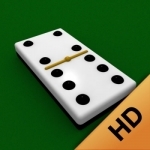
Domino Touch HD
Games
App
A traditional and excellent board game that you can carry anywhere and play anytime! Domino...
